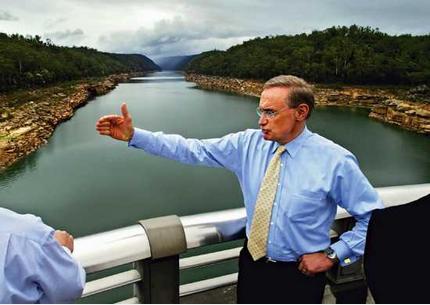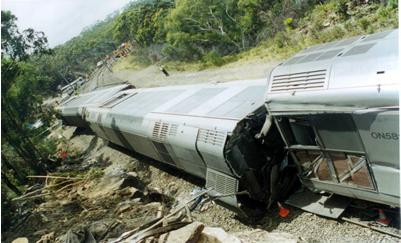
Chapter 3: Carr’s policy pendulum had reached its apex
Retired Premier Neville Wran described Carr as "the very model of a modern Labor premier, an articulate and powerful public performer who identified himself with the contemporary policy issues of education and the environment."1
Media commentary following Carr's retirement noted that Carr’s legacy was characterised by his successful Olympics (‘the best games ever’) and massive investment in capital works into hospitals, child protection services, improvements to education standards and literacy rates, in paying of the States debt.2 Most notably, Carr’s legacy is his commitment to protecting the natural, creating 350 new national parks, saving the South East forests and introducing native vegetation reforms.3

Carr is also credited for industrial relations reform, that NSW was the first state to apologise for the Stolen Generations and that his Government has stood with asbestos victims seeking compensation from James Hardie.4
In hindsight, possibly the pinnacle of Carr’s Premiership was the first day of the Sydney Olympics, Saturday 16th September 2000. Carr recalls:
They were old Australians and new Australians and I felt for the first time the sheer honour of representing these people and of being able to make decisions on their behalf at this time, perhaps the happiest time in Australian history.”
“I remember the first day of the Sydney Olympics, when Helena and I strolled up Circular Quay, after the start of the first Games event on the harbour, and we met Australians from very many backgrounds, united in pride in their city and excitement with the previous night's opening ceremony.
These were NSW’s glory days. A new century, a buoyant economy, a big head; Carr’s home town Sydney all spruced up to host the Olympic Games on the world stage.
Carr, a former journalist, was an adept manager of the media. He was able to anticipate and head off potentially damaging issues and close down debate. Although some of Labor’s internal debate and threats presented by a media-driven policy agenda, make it into the public realm.6 From 2004 as Labor fell into a policy hole, Carr had allowed NSW Labor to become publically criticised for failures in the State’s public infrastructure (rail safety, roads, hospitals, electricity) as a result of poor long-term planning and economic growth across the State was starting to slow as a result. By 2004, basking in the Olympic glow had allowed the State to lag economically. The Waterfall Train Derailment in early 2003 had focused media attention on the problems with the NSW passenger rail system.

The Waterfall Train Derailment, 31-Jan-03, involved a 4-car commuter train derailed south of Waterfall Station.
The NSW Opposition had highlighted the State’s worsening economic conditions, systemic problems with Sydney’s trains and with the health system. Opposition Leader John Brogden proposed Carr’s reason for quitting:
"So, as he looked to the next 20 months, I think he realised that things were going to get worse and not better, so as a clever politician he picked his time to go."7
Daily newspapers and radio shock jocks are unrelenting in their criticism of government and can wear anyone down over time. Certainly, public feeling had turned against Carr, but the Sydney media have rarely been kind to NSW governments as it doesn’t sell papers or attract ratings.
Carr came under direct attack from Sydney Radio 2UE’s popular announcer, Alan Jones, who Carr labelled as a Liberal Party pamphleteer. Carr had instructed his ministerial staff to monitor Jones meticulously to prepare same-day responses and action plans to address any issue raised.8
A year after Carr’s resignation, he was interviewed by the ABC’s Maxine McKew about his time in office. Carr said of the Sydney Morning’s Herald’s campaign against him labelled ‘The Great Carr Crash’:
"Oh yeah, it was barking mad. In ten years as Premier we allocated 61 billion to new capital works and throughout all that period the Fairfax media attacked me for spending too much money. Now under this editor, they switch their line.”9
Political columnist Shelly Savage at the time of Carr’s resignation observed, that Carr’s later-term style was typified by a more cautious policy approach, letting the ball drop in regard to funding the public transport system.10
Columnist, Michael Duffy, at the time of Carr’s resignation reflected on the rail tragedies of Glenbrook and Waterfall under Carr’s premiership, the series of devastation bushfires across the state, the mismanagement of national parks and the increased unaffordability and unavailability of housing across Sydney.11
Carr’s environmental legacy was undermined by his signing of regional forest agreements with the Howard federal government respectively in 2000 and 2001 allowing logging in old growth native forests on the State’s North East, Southern and Eden hinterlands.12
Perhaps the single act that undermined Carr’s legacy, and in particular his credited environmental legacy, was his undermining of environmental protection legislation on the introduction of the infamous Part 3A environmental amendment Bill in the weeks before his resignation.
Carr’s then Minister for Planning, Craig Knowles, introduced the Bill in the Legislative Assembly on 27th May 2005. The Bill effectively changed the Environmental Planning and Assessment Act to allow the Minister of Planning to overrule environmental restrictions on any development proposal the Minister deemed a ‘major project’ or ‘critical infrastructure’. So it was a transfer of absolute planning power to the Minister for Planning and a removal of public transparency, local accountability and consultation and all appeal rights regarding land use development through the State.
Clearly this law played into the hands of the powerful corporate developer lobby which had become strong backers of the NSW Right in political donations. It was an early sign that the NSW Right was reacting to the slowdown in the NSW economy. The government’s fastest and easiest way to reinvigorate growth was to facilitate development by simply changing the planning laws to overcome environmental compliance hurdles.
Knowles in his speech introducing the bill two months before Carr resigned said:
"There is no doubt that this bill dramatically improves the climate in which to do business in this State. The bill implements important elements of this Government's planning reform program—a program which is overhauling our planning system and cutting red tape at all levels…" 13
And so upon ‘Part 3A’ Bill being introduced to Parliament on 27th May 2005 so began a retrograde chapter in NSW political history. The NSW Right in order to achieve its end of economic growth was now prepared to undermine the democratic planning process and do as Graham Richardson once coined, “whatever it takes!”.14
The Labor factions had also become critical of Carr to the point of seeking vengeance, but that is a topic for the next chapter.

‘the best games ever’
[Next Chapter ] [Previous Chapter ]
References:
[1] The Age Editorial, ‘Closing a big chapter in the Bob Carr story’, 28th July 2005, http://www.theage.com.au/news/editorial/closing-a-big-chapter-in-the-bob-carr-story/2005/07/27/1122143904728.html
[2] Sydney Morning Herald, ‘Bob Carr quits as Premier’, by Anne Davies, 27 July 2005, http://www.smh.com.au/news/national/bob-carr-quits-as-premier/2005/07/27/1122143879338.html,
[3] Bob Carr’s Speech, (27th July 2005), The Age, http://www.theage.com.au/news/national/bob-carrs-speech/2005/07/27/1122143898973.html
[4] ABC News Online, ‘Carr quits’,27th July 2005, http://www.abc.net.au/news/newsitems/200507/s1423278.htm
[5] Reporter: Samantha Hawley (Reporter), ‘Sunny day sparks Bob Carr's resignation’, Wednesday 27th July 2005, ABC Radio ‘PM’ Programme, http://www.abc.net.au/pm/content/2005/s1423837.htm
[6] Quentin Dempster, ‘Media rules in the court of Carr’, 2005, The Griffith Review Edition 3, Griffith University & the author, http://www.griffithreview.com/edition-3/116-reportage/490.html
[7] Samantha Hawley, loc. cit., http://www.abc.net.au/news/newsitems/200507/s1423278.htm
[8] Quentin Dempster, loc.cit., http://www.griffithreview.com/edition-3/116-reportage/490.html
[9] Maxine McKew (interviewer), ‘Bob Carr: Making History’, Sunday 13th August 2006, ABC Radio ‘Sunday Profile programme, http://www.abc.net.au/sundayprofile/stories/s1713499.htm
[10] Shelly Savage, ‘Bob Carr, erudite and urbane?’, 29th July 2005, On Line Opinion, http://www.onlineopinion.com.au/view.asp?article=3732&page=1
[11] Michael Duffy, ‘Green Legacy a Black Mark’, 30th July 2005, The Sydney Moring Herald, http://www.smh.com.au/news/opinion/green-legacy-a-black-mark/2005/07/29/1122144018993.html.
[12] Australian Government, Department of Agriculture Fisheries and Forestry, http://www.daff.gov.au/rfa/publications/annual-reports/nsw/regional_forest_agreement_for_southern_new_south_wales_annual_report
[13] Nature Conservation Council of NSW, NCC Home >Coastal & Urban Sustainability > Planning & Law Reform Major Projects (Part 3A), http://www.nccnsw.org.au/index.php?option=com_content&task=view&id=1712&Itemid=871
[14] Joe Sammaras, Monday, 23rd November 2009, ‘The NSW Right is a dead, dead duck’, Crikey, http://www.crikey.com.au/2009/11/23/the-nsw-right-is-a-dead-dead-duck/
[online material accessed 9th June 2010]

Add comment